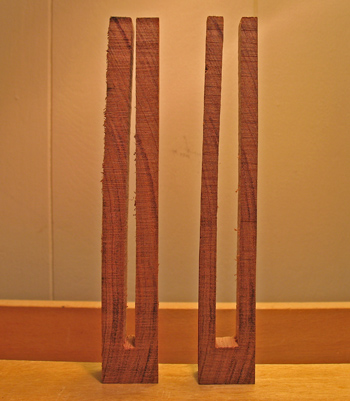If I have a nice board and want a successful resaw I need all my ducks in a row: a good bandsaw with sufficient power, an appropriate blade that is sharp, clean, and properly tensioned, an adequately high fence corrected for blade drift if necessary, good dust collection, and a safe plan to feed and support the board all the way through the cut. The board needs at least one flat face and a straight edge square to the face.
Even with all the mechanical preparations it’s necessary to consider the properties of the wood to avoid disappointment. When I bring new wood into the shop I check its moisture content with a pinless meter and write the date and MC% on the board. I stack and sticker the boards and monitor the MC over the next few days to few months, noting when it seems to level off, accounting for the humidity in the shop. For thick stock, if I can crosscut away from the ends of the board, I like to check for any moisture gradient across the thickness of the board. Ideally, I want a board that has equilibrated to the shop air with uniform MC through the full thickness.
There is one more very important issue. Dried wood can have internal stresses that manifest immediately after resawing. Very often, in resawing a board down the middle the two pieces produced promptly cup toward each other; the sawn faces both become concave across their widths. This immediate change is not due to drying or moisture issues, although those still might later create gradual movement of the boards.
To detect stresses in a board I take a short end cut, preferably away from either original end of the board where end checks may be present, saw out a center section and observe the remaining prongs of wood. In the sample above, the inward bow, especially of the left prong, shows just a slight casehardening effect. The sample on the right, with more of the core removed, shows a bit less bowing. (The moisture content is a uniform 6%.) Resawing this board would probably give good results.
Severe bowing of the prongs would predict markedly cupped boards from the resaw. Such boards would lose much of their thickness after flattening. I would use a fence with no outfeed length (beyond the blade) since the cupped surface coming off the blade would not register properly. Better to find another board to resaw.
A thought on design: in general, I’m not fond of perfectly bookmatched pieces juxtaposed in furniture. There’s something too contrived about that, to my eye. I like harmonious unity with a dose of organic variety better than mirror repetition.
As always, happy woodworking.



Rob – I’m about to try this trick on some boards I have. A question as I go about it — the samples you show above – would you go ahead and resaw either of those — they are both “OK”, as in just slight bowing so that a resaw and cleanup should work pretty well?
Another question – I’m probably going to need to take down an 8/4 to about 1.5″ finished thickness. I’d like to resaw to save my planar all that hard work. If I do this trick to test the wood, and it looks like just slight case hardening, can I take 3/8″ off one side and then joint/plane from there or will taking that much off one side lead to serious problems (again, if the test above shows about the same as your example)?
Thanks – this is awesome stuff and perfect timing.
Morton++
Hi Morton,
Sure, those boards above would be fine to resaw. The key is to allow for the anticipated distortion. Removing the cupping will lose some thickness, and don’t forget there may be some bowing (i.e., bending of the face along the length of the board). If I were getting three boards out of the original stock, then I’d saw the two outer ones a bit thicker than the middle one. The middle one is balanced and probably will stay flatter.
For your 8/4 board, I suggest the safest way is to remove about equal thicknesses of wood from each side with whatever tool is easiest.
Also, check for any moisture content gradient across the thickness with a pin meter if you have one. I’d also hedge my bets by bringing it down to 1 5/8″ or so, then observe it – for a few days if there was a moisture content gradient, but just briefly if not. Then go for the final thickness.
Thickness has a way of disappearing fast and it pays to watch the wood, as you know.
Hope this helps.
Rob